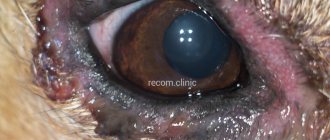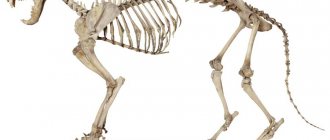About the symptoms of pathology
The main symptoms indicating a concussion are vomiting and a staggering gait of the animal, loss of coordination of movements, and spinning in one place.
Loss of consciousness is also possible. If, after any kind of injury, a pet becomes indifferent to everything that happens nearby and around, loses interest in the world around it and does not respond to the owner’s call, then most likely these are also signs of a concussion. When the injury is not very serious, the animal comes to its senses in a short time, and the painful symptoms gradually disappear. If the case is severe, the consequences can be very unpleasant: from loss of consciousness to death. The dog has wide open pupils, “ranging” eyes, trembling of the eyeballs, involuntary release of feces and urine, convulsions and sudden jumps in intracranial pressure, mucous membranes become pale or red, twitching of the muscles of the muzzle and neck is observed, fear of noise or too bright light, temporary hearing loss.
Signs of a concussion in a dog may appear hours or days after the injury. Therefore, the owner, knowing about bodily injuries and blows, must show maximum attention to the pet and show it to the veterinarian, regardless of the animal’s well-being.
The owner of the dog with the above symptoms must immediately call a veterinarian or send the victim to the clinic.
If the pet has lost consciousness, then before transporting it to a medical facility, lay it on its right side and unfasten the collar. Apply a cold compress or bag filled with ice cubes to his head. Make sure that the dog's tongue sticks out: if the organ gets stuck in the throat, the dog may die from suffocation. As soon as your pet regains consciousness, seek medical help.
Consequences of a concussion or what to expect after
Pets can suffer injuries to the head area as a result of the following reasons:
- Road traffic accidents. Mobile and active pets often become victims of collisions with vehicles. Heavy parts of moving mechanisms cause serious damage to the bones of the skull.
- Falling from height. The reason is relevant mainly for miniature and dwarf breeds.
- Blows to the head due to animal cruelty.
- Hunting dogs often suffer severe skull injuries when colliding with foreign objects (such as wood) while pursuing prey.
- Gunshot wounds.
Depending on the force of impact on the bones of the skull, the type of damage, and the characteristics of the object, the injury can be open or closed. Experts distinguish between depressed, linear and stellate fractures of the cranial bones. One of the severe injuries is considered to be trauma to the base of the skull, which is associated with the risk of infection entering the brain.
If the head injury is not accompanied by a violation of the integrity of the bones, then the animal may develop a bruise, concussion, concussion, and swelling. The greatest danger to a dog’s life is edema and hematoma of the brain. As a rule, most traumatic brain injuries are accompanied by increased intracranial pressure.
Cranial injury in a four-legged pet is dangerous primarily by the development of complications such as stroke, intracranial hematomas, the formation of a cranial hernia, and thromboembolism.
Brain damage is often accompanied by the development of disorders in the spinal region. In this case, there is a loss of sensitivity in the front and hind limbs, paresis, and paralysis.
The prognosis for brain damage due to mechanical trauma to the skull depends on a number of factors. As a rule, minor injuries accompanied by a bruise, contusion or mild concussion have a favorable outcome. In cases where a traumatic brain injury is associated with the formation of a hematoma and the penetration of foreign objects into the brain tissue, the prognosis is cautious.
Coma lasting more than 24 hours indicates deep damage to the central nervous system. The presence of severe neurological symptoms also becomes a harbinger of death.
Traumatic brain injury in dogs is a complex injury. As a rule, the disease occurs when a vehicle collides with a vehicle, falls from a height, or hits the skull. In veterinary practice, a distinction is made between concussion, concussion and cerebral edema. A complication of the injury is a hematoma, an intracranial hernia.
The therapy is comprehensive and does not exclude surgical intervention. The prognosis for severe brain injuries accompanied by neurological symptoms and coma is poor.
Even a mild, asymptomatic concussion in a dog can lead to severe, irreversible consequences. Especially if the owner neglected to visit the clinic and tried to help the pet on his own. In what cases is a concussion suspected, how to provide first aid and how to properly transport your four-legged friend? Every owner should know this, but only a doctor should treat a concussion.
From an accident to hitting the corner of a wall, from a fall from a height to any more or less heavy object falling on your head. Airedale terrier Millie received a concussion when the owner accidentally swept a cup off the table, and it fell right on the pet’s head. The greyhound Glasha was racing at full speed during coursing training and crashed into a tree trunk at full speed.
Depending on the force of impact on the bones of the skull, the type of damage, and the characteristics of the object, the injury can be open or closed. Experts distinguish between depressed, linear and stellate fractures of the cranial bones. One of the severe injuries is considered to be trauma to the base of the skull, which is associated with the risk of infection entering the brain.
How long does it take for a concussion to heal? With timely assistance, all symptoms of head injury gradually disappear after 2-3 days. After about a week and a half (7-10 days), all functions and the original state of the brain cells are fully restored.
If the concussion was not severe and the necessary medical assistance was provided in a timely manner, then almost all consequences can be avoided. With serious head injuries, unfortunately, there may be consequences.
- periodic panic attacks;
- sudden unexplained aggression (short-term attacks);
- status epilepticus;
- increased sensitivity to changes in ambient temperatures and weather dependence (mood and health status change depending on the weather);
- hearing and/or vision impairment;
- paralysis.
Regardless of the dog’s condition after the injury and how long it took for the concussion to heal, the animal should be under the supervision of veterinary specialists for several months, because Symptoms may return at any time.
Violation of the anatomical integrity of the skull bones in domestic animals is a serious injury and is associated with a long period of rehabilitation. The difficulty of diagnosis lies in the fact that the clinical picture can be observed several days after the mechanical damage. In some cases, only a timely surgical operation can help a four-legged pet.
Introduction
The primary lesions can no longer be affected.
Only removal of hematomas or stabilization of fractures is possible (if necessary). Injury to the brain parenchyma, in addition to primary damage, causes a cascade of biochemical processes (secondary damage), which have an even more negative effect on neurons and lead to a further increase in ICP [12]. ATP depletion leads to the accumulation of calcium and sodium in cells. This causes cell swelling and depolarization. Uncontrolled depolarization leads to the release of large amounts of glutamate (an excitatory neurotransmitter), resulting in even greater calcium accumulation in neurons. Elevated calcium levels activate a number of mechanisms (arachidonic acid cascade, accumulation of free radicals), further damaging brain tissue. The bones of the skull form the inelastic cranium, which contains the brain, blood and cerebrospinal fluid. Intracranial pressure in dogs and cats is 5–12 mmHg. Art. After head trauma, the volume of intracranial structures increases due to swelling, bleeding and accumulation of cerebrospinal fluid. The brain has the ability to compensate for small increases in ICP by changing the volume of other parts. This is described by the Monroe-Kelly doctrine [10, 14]. Bypassing the cerebrospinal fluid, reducing its production and increasing absorption, as well as increasing venous outflow leads to a rapid decrease in ICP. At this compensatory stage, the patient may appear clinically relatively normal. But then (after overcoming compensatory capabilities), even a slight increase in ICP will lead to a significant deterioration in the neurological condition. As ICP continues to rise, a brain herniation may also develop. There are 4 variants of brain herniation (Fig. 5): ⦁ through the falx of the brain; ⦁ transtentorial hernia - a hernia of the brain through the tentorium cerebelli (tentorium cerebelli) - leads to compression of the midbrain and causes mydriasis, a decrease in the pupillary reflex and a decrease in the level of consciousness; ⦁ herniation of the cerebellum through the foramen magnum usually leads to rapidly developing respiratory arrest due to compression of the respiratory centers in the medulla oblongata; ⦁ brain herniation through defects in the skull.
About veterinary care for concussions
Treatment is determined by a veterinarian after examining the animal, the results of x-rays, computed tomography, and consultation with a neurologist. Depending on the severity of the concussion, treatment is prescribed. In order to reduce the expected swelling of the organ, a 10% solution of calcium chloride is administered intravenously to the pet. Often in such a situation, the drug Traumeel is used, which is administered to the animal two to three times a day for two weeks.
The specialist prescribes dietary nutrition and biological supplements to the injured dog to help with this particular diagnosis. The patient should be fed in small portions. It is important to follow the regime. The pet should be completely at rest, not play, not walk, not exercise until complete recovery.
If the sick dog’s condition is serious, then it must be left in the clinic for several days under the close supervision of specialists. During the rehabilitation period, surround the dog with care and attention. High-quality care, assistance from a specialist doctor and adequate treatment, a good attitude will help your friend overcome his illness faster, and most importantly, avoid serious and dangerous consequences for his health.
Almost every home has a dog. She is a wonderful guard and devoted friend. This pet becomes an equal member of the family, which is why the dog’s health is not unimportant. There are many different diseases in dogs. This article will focus on concussions. This is a traumatic brain injury.
Treatment
It would be ideal if a dog’s concussion and its treatment are monitored by a veterinary specialist throughout the entire therapeutic course. The veterinarian assesses the animal’s condition and prescribes treatment based on personal observations and medical history from the owner of the four-legged patient. During the course, medications and their dosages can be replaced by one another, depending on the body’s response to the medication.
For a complete diagnosis it is recommended:
- take an X-ray of the skull to rule out fractures or splits of the cranial bones, as well as displacement of the cervical vertebrae;
- conduct a computed tomography scan to assess the extent of brain damage;
- Additionally, obtain advice from a veterinary ophthalmologist and neurologist.
Medications
Preventing cerebral edema
Calcium chloride 10% Twice a day intravenously for 1-2 weeks, depending on the severity of the condition and the risk of developing cerebral edema. Mannitol (Mannitol) 15% Administer slowly by drip (from 20 minutes to half an hour) at the rate of 0.25-2 g /kg daily for as many days as the situation requires, but at least 3 days. Furosemide 5% (diuretic) Intramuscularly from 0.5 to 2 ml 1-2 times a day for 3-5 days, depending on the condition. Use caution if you have kidney problems.Improving cerebral circulation
Mexidol-Vet 2.5% Intravenously or into the muscle 0.5 ml/kg during the first week, and then 0.25 ml/kg for another 2-3 weeks. Cerebrolysin 1 to 5 ml intramuscularly 1-2 times a day day for at least a month. Piracetam Intramuscularly from 1 to 5 ml 1-2 times a day, depending on the severity of the condition. The course is at least 14 days. Cinnarizine ½ tablet. twice a day for a course of 1 month. Monitor the dynamics, the dose can be increased to 1 tablet in special conditions. Actovegin Intramuscularly, 1 ml 1-2 times a day for 1-3 weeks. The first week - daily, then every other day.Painkillers, antispasmodics
Papaverine Subcutaneous or intramuscular 1-3 mg/kg twice a day or as required. Traumatin Subcutaneous or intramuscular 0.1 ml/kg, but not more than 4 ml at a time. Symptomatically. Baralgin 0.1 ml/kg intramuscularly in the morning and evening or on demand when the dog is clearly in pain.Consequences for the animal
A pet with a traumatic brain injury requires complete physical and emotional rest. If the severity of the injury allows for treatment at home, the owner should pay maximum attention to caring for the sick dog.
The animal must be placed in a warm and dry room. It is important to protect your pet from communication with children and strangers. To avoid overstimulation of the nervous system, silence should be maintained when caring for a sick dog. It is advisable to shade the room where the animal is located from bright light. Walking outside is not recommended until complete recovery.
The owner must be patient, since complete restoration of neurological functions may occur only several months after the injury.
Veterinary experts recommend visiting a veterinarian once every three months throughout the year in order to correct the course of treatment, assess the clinical condition and the process of restoring brain function.
Types of concussion
Several types of concussion are classified depending on the severity:
- Mild degree - characterized by mild symptoms. Not so dangerous.
- Moderate severity—more pronounced symptoms and already poses a danger to the dog’s life.
- Severe degree is the most dangerous; if not treated in time, it can result in death for the pet.
- Mild degree - characterized by mild symptoms. Not so dangerous.
- Moderate severity—more pronounced symptoms and already poses a danger to the dog’s life.
- Severe degree is the most dangerous; if not treated in time, it can result in death for the pet.
Examinations at the veterinarian
Having discovered the fact of mechanical damage to the brain, the owner must:
it is possible to take your pet to a specialized facility as soon as possible, even in the absence of pronounced clinical signs.
The veterinarian will perform a neurological assessment of the severity of the lesion. At the same time, consciousness, preservation of reflexes, the state of motor function, the nature of breathing and the state of cardiac activity are assessed.
When assessing motor function, the veterinarian pays attention to the presence of paresis or paralysis. Assessment of consciousness allows us to identify depression of nervous activity, stupor, coma. An important place in the diagnosis of traumatic brain injury in animals is occupied by the analysis of brain stem reflexes.
Based on the condition of the pupils, an experienced neurologist will determine the location of the brain lesion. Thus, the presence of miosis (significant constriction of the pupil), as a rule, indicates injury to the diencephalon. Damage to the midbrain or the development of a hernia is indicated by bilateral mydriasis.
If there is a transition from a state of miosis to dilation of the pupil, then the phenomenon indicates a deterioration in the neurological condition of the animal. Examination of the pupil is carried out using ophthalmoscopy. The same method allows you to identify increased intracranial pressure, characteristic of brain injuries, and assess the condition of the fundus vessels.
X-ray examination
In order to visualize the damage, a sick pet undergoes an X-ray examination of the head. The method allows you to detect fractures of the skull bones, the presence of foreign bodies, for example, shotgun pellets. In a specialized clinic, a sick pet will be prescribed a computed tomography and magnetic resonance imaging scan.
Visual diagnostic methods can detect intracranial injuries, for example, subepidural hematomas, secondary cerebral edema.
Having discovered the fact of mechanical damage to the brain, the owner must take the pet to a specialized institution as soon as possible, even in the absence of pronounced clinical signs.
X-ray examination
In order to visualize the damage, a sick pet undergoes an X-ray examination of the head. The method allows you to detect fractures of the skull bones, the presence of foreign bodies, for example, shotgun pellets. In a specialized clinic, a sick pet will be prescribed a computed tomography and magnetic resonance imaging scan.
How are head injuries treated?
At the moment of impact, primary damage to the brain tissue occurs, resulting in the development of edema syndrome, and multiple hemorrhages may occur.
In the absence of emergency care, there is a high probability of developing secondary pathologies:
- strokes;
- intracranial hematomas;
- generalized cerebral edema;
- formation of a cranial hernia.
The severity of the consequences depends on the nature of the mechanical impact, its strength and the location where the impact occurred.
Head injuries are best treated in a clinic where the patient is closely monitored. The doctor’s main task is to prevent further tissue destruction and prevent nerve dysfunction from developing.
That's why:
- To restore the volume of circulating blood, isotonic and colloidal solutions are administered.
- Hypertension caused by overexcitation is treated with painkillers and sedatives.
- Barbiturates are used to relieve seizures.
- To support the heart - corticosteroids.
- If there is a fracture of the skull bones with depression of fragments, infection of the wound, as well as intracranial hematoma and bleeding, the animal is urgently operated on.
How can you tell if your dog has a concussion?
The main signs of a concussion cannot be confused with anything else:
- lack of coordination of movements, unsteady gait, aimless walking in circles. A dog can show aggression for no reason, look around, be frightened by something invisible, growl;
- vomit;
- apathy, lethargy, lack of response to the owner’s call;
- lack of appetite and thirst;
- dilated pupils or their different shapes;
- trembling of the eyeballs, inability to focus on anything specific, fear of bright light;
- shaking of the limbs, vaguely similar to convulsions (but not convulsions), paralysis or paresis (failure of the front or rear limbs);
- involuntary urination;
- whining;
- headache, which is manifested by attempts to lean against something cold, while if you try to pat the dog on the head, it will not let you;
- change in color of the mucous membranes from too pale to deep red;
- the animal tries to grab the air or people nearby with its mouth, but does it somehow unconsciously (with this sign it is important to secure the mouth with a muzzle or simply bandage it with whatever is at hand - a bandage, a belt, a belt);
- loss of consciousness is possible for various periods of time, and in special cases, death without regaining consciousness. It is especially unfavorable if the animal does not lose consciousness immediately, but after some time;
- stopping breathing or heartbeat.
The peculiarity of the manifestation of concussion symptoms in dogs is the time intervals. Symptoms may appear immediately, or may take several hours or even days. That is why, if the owner witnesses any head injury - a fall or a blow - he should show the dog to a specialist immediately, without waiting for something to begin to appear outwardly.
- The main signs that a dog could have suffered a concussion are a staggering gait, loss of coordination, and circling in place.
- Loss of consciousness is also possible.
- If, after a fall or blow to a dog, the animal (after a blow to the head, injury) does not respond to the owner’s call, it has lost interest in the world around it, is indifferent to everything and lethargic. This most likely means the animal has suffered a concussion.
- Often, brain damage is manifested by flapping and trembling of the limbs.
- The dog may gasp for air or at people nearby.
Therefore, immediately after receiving an injury, it is better not to pet the animal, but the mouth can be tied with a strap. If the injury is mild, the dog comes to its senses within a few minutes and no longer exhibits any painful symptoms.
If the case is severe, the dog loses consciousness and may die without regaining consciousness. At the same time, her pupils are wide open, her eyes run wide, and her eyeballs tremble. The animal may involuntarily excrete feces and urine.
First aid
With such symptoms and if there was a previous head injury or fall, the animal must be taken to the veterinarian as soon as possible. If the dog has lost consciousness, it must be laid on its side and the collar must be unfastened. It is best to apply a cold compress to your pet’s head, or if possible, an ice pack.
The dog's tongue must be protruded so that it does not get stuck in the throat and the animal does not die as a result of suffocation. As soon as the dog comes to his senses, you need to immediately call a veterinarian at home or take the animal to the clinic.
Treatment is prescribed by a veterinarian after assessing the severity of the concussion. So, in order to reduce possible brain swelling, a 10% calcium chloride solution is administered intravenously to the animal. Often in such cases the drug traumeel is used.
It is administered 2-3 times a day into the dog’s body for 14 days. It is also recommended to use special dietary supplements that help specifically with concussions. During the treatment of a dog with such an injury, it should be provided with complete rest: active games and long walks, any sports competitions and training should be excluded.
Read in this article
Not only humans, but also any pet can get a concussion. Owners of dogs of different breeds often turn to us for help - from large hunting and guard dogs to small decorative dogs. Treatment of this condition is very important, since timely measures taken can save the health and even life of the pet.
To understand what measures to take and when to sound the alarm, the owner of the animal must know and be able to distinguish the symptoms that accompany a concussion in a dog. The speed of recovery of a four-legged tailed patient largely depends on the time of contacting a veterinarian.
There are many reasons why a dog can have a concussion. In most cases, they are similar to incidents that cause the same consequences in people:
- Road traffic accidents. This is the most common reason - dogs often fall under the wheels of cars and receive head injuries of varying degrees of intensity.
- A fall. A dog can be injured even if it falls from a small height. Small representatives of dogs can be injured if they fall out of the owner’s hands or from a special bag or carrier.
- Head injuries associated with blows to the skull. These could be careless actions of the animal itself or the owner who dropped something heavy on the dog, as well as violent actions of immoral individuals beating the dog. Falling something heavy on your head can cause not only a concussion, but also various injuries to the skull, including open wounds that require immediate response and urgent medical care.
- Gunshot wounds to the head. Most often, representatives of hunting breeds suffer from this, but similar incidents can happen to other animals. Fortunately, this is a rare case of injury.
- Sometimes dogs injure themselves, leading to a concussion in the dog. During hunting, playing, or active running, she can hit hard against various objects - corners of furniture, wall ledges, trees, large stones, and so on. Hitting your head can cause a concussion.
According to the degree of intensity, head injuries that provoked a concussion are divided into:
- Lungs. They do not threaten the health and life of the dog.
- Average. They can affect the well-being and health of the animal.
- Heavy. Such lesions are life-threatening.
The causes of concussions in dogs vary, but the consequences for all of them can be very dangerous.
Therefore, such conditions require careful attention and high-quality treatment, taking into account the severity of the lesion, weight, size and age of the animal.
First signs
A dog that has suffered a concussion may behave normally with a minor injury. With more severe injuries, the following signs and symptoms of a dog concussion occur:
- Lethargy, inert behavior, apathy. These are usually the first signs of a mild concussion.
- Headache, due to which the animal either tries to keep its head unnaturally straight and still, or shakes it vigorously.
- Impaired coordination of movements.
- Nausea, vomiting.
- Lack of appetite.
- The dog sleeps a lot, tries to hide from everyone, even from its owners.
- Loss of consciousness, unexpected fainting. Loss of consciousness is especially dangerous if the animal is constantly vomiting - it can choke on its own vomit.
- Inappropriate behavior up to and including attacks on its owner and strangers.
- In severe cases, breathing and heartbeat disturbances occur, and the pupils are dilated over the entire eye and do not respond.
Depending on the dog’s condition, appropriate assistance is provided.
If your dog has a concussion, it definitely needs help. To do this, perform the following steps:
- You need to remove the dog's collar, muzzle, and everything that may hinder its movements and breathing.
- Place it on its side on a flat, hard surface.
- Remove the tongue so that if she loses consciousness, she cannot choke or suffocate on it.
- Check pulse and breathing.
- Apply a cold compress to your head (you can use an ice pack).
- Seek veterinary help.
If your dog has been hit by a car, or has additional injuries, especially fractures and open wounds, you should try to call an emergency veterinarian or a doctor at home.
At the hospital, specialists will immediately notice that the animal’s pupils are dilated throughout the entire eye, and will send it for a computed tomography scan. Using this modern diagnostic method, you can quickly determine the level of brain damage and the area of its spread.
Therapy and treatment
Treatment of a concussion in a dog should only be done by a professional. Self-medication can lead to unpredictable consequences, including the death of the dog. Only a veterinarian can treat such a dangerous lesion. He will determine his patient’s condition and select individual treatment methods based on the level of damage, age, weight and breed of the dog.
In the case when a head injury causes disturbances in consciousness, if the dog does not respond to external stimuli, you should urgently contact a veterinarian.
Delay can be extremely dangerous. Doctors prescribe treatment that is very similar to the same actions for concussions in humans, but with the adjustment that the drugs must be intended for veterinary purposes.
Self-medication carries a huge danger, so you can use any drugs only at the discretion of the veterinarian and judging by the condition of the dog. It must be remembered that some “human” drugs can lead to extremely undesirable consequences.
If your pet has suffered a head injury, then the first thing that needs to be done for him at home is to provide complete rest, warmth, absence of drafts, a sufficient amount of clean water, and light food. If the animal's condition does not improve for several days, it must be taken to the clinic.
Pet owners are concerned about how long it takes for a concussion to heal. This depends on the severity of the damage. For minor injuries, this will take a few days to a couple of weeks, moderate concussions require a longer recovery period, and rehabilitation after severe injuries takes months.
Consequences
The consequences of the condition depend on the extent of the damage and the severity of the injury. If the level of nerve damage is high, mobility impairments, paresis and paralysis, impaired coordination of movement, vision and hearing, intestinal atony and other dangerous problems may occur.
Prevention
How to prevent concussions in animals? To protect your dog from injury, the following recommendations must be followed:
- Do not let your pet go for independent walks.
- During walks, let your dog off the leash only in safe places.
- Outdoor games and training sessions can only be carried out in open spaces. It is necessary to ensure that there are no large stones or trees nearby.
- You should remove all dangerous objects in the apartment that could fall on the dog’s head.
Even a minor concussion can lead to bad consequences without proper treatment. Therefore, if you suspect that your pet has received such an injury, you should rush to the veterinary clinic.
Concussion in a dog: symptoms, when it goes away, consequences, signs, how to determine
The external manifestations of the injury received by a four-legged friend may not be noticeable if the blow to the head was of little force.
Obvious signs of traumatic brain injury are the following symptoms: - dilated pupils; - twitching of paws or neck; - sudden fainting; - eye trembling; - redness or paleness of mucous membranes; - changes in heart rate and breathing; - whining, temporary loss of vision and hearing.
If a pet has received a blow to the head, the owner needs to be attentive to the appearance of such symptoms.
How to treat a concussion in a dog and how to treat it
Only a veterinarian can determine how to treat a concussion in a particular case during an in-person examination. You need to call him at home or take your pet to a veterinary clinic.
An example of prescribing medications for a four-month-old toy terrier who received a concussion after falling out of bed: - Cebrolysin 0.4 ml intramuscularly 1 time per day; — Travmatin 0.5 ml subcutaneously 1 time per day; — Mexidol ½ tablet 1 time a day.
It is important to provide your pet with rest, adequate nutrition and, if necessary, vitamin and mineral supplements for a speedy recovery. A veterinarian should observe the dog daily until it is completely recovered.
A dog has a concussion, what to do and what pills to give
When treating a concussion in a dog, symptomatic therapy is indicated. It is necessary to eliminate the consequences of the injury and alleviate the pet’s condition. First aid is to apply a cold compress to the dog’s head before the doctor arrives and inject diphenhydramine.
To treat a dog, the drug Traumeel or Traumatin may be prescribed. Mexidol tablets are given for traumatic brain injuries, depending on the weight of the animal and its condition.
During an exacerbation, the dose of the drug is 10-15 mg per 1 kilogram of weight, then the dose is reduced to 5 mg per 1 kilogram.
Tablets are given two or three times a day, depending on the doctor's prescription.
Treatment of a concussion in a dog at home
After visiting a veterinary clinic or calling a doctor at home, treatment is carried out in accordance with his prescription. In addition to medications, the animal needs complete rest, good, nutritious nutrition.
If a concussion is not treated, the animal may go blind or develop epilepsy. It is difficult to predict how a concussion will manifest itself in the future. Therefore, if the animal is in serious condition and requires drips, intravenous injections and additional examinations, it is better to leave it for several days in a veterinary clinic.
Head injuries in dogs cause serious health problems and require long-term treatment. We are, of course, talking about injuries compatible with life. The main causes of head injuries are:
- blows;
- getting hit by a car;
- falling from height.
If the accident occurred in front of the owner, he should immediately take the animal to a veterinary clinic, even if there are no visible changes in the dog’s behavior. The fact is that the consequences of the injury can appear 5-6 days after the incident. Time must not be wasted, then treatment of the injured animal will be most effective.











